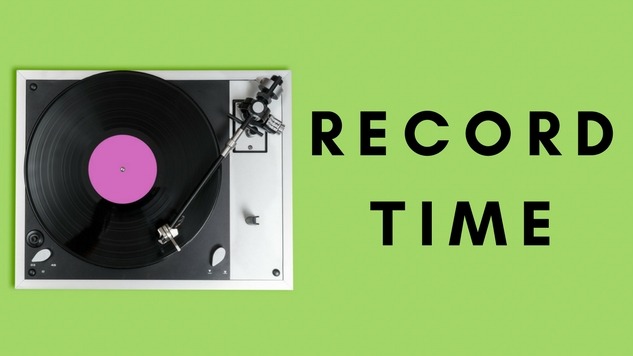Record Time is Paste’s monthly column that takes a glimpse into the wide array of new vinyl releases that are currently flooding record stores around the world. Rather than run down every fresh bit of wax in the marketplace, we’ll home in on special editions, reissues and unusual titles that come across our desk with an interest in discussing both the music and how it is pressed and presented. This month that includes a boxed set of quiet storm classics, new material from a Chicago spiritual jazz leader and some choice cuts from tomorrow’s Record Store Day Drop.
Booker T. & the M.G.’s: McLemore Avenue (Craft Recordings)
The penultimate album recorded by the original lineup of Booker T. & the M.G.’s was a tribute to another penultimate album: the Beatles’ Abbey Road. As the story goes, keyboardist Booker T. Jones heard the Fab Four’s final recorded work during a trip to California and was so blown away by it that he insisted that his group pay homage to it. The M.G.’s did so by following the template of the suite that closes out Abbey Road, mixing the material into long medleys that shifted tempo and feel at will. They stayed true to the melodies of the original tunes, but gave the psych pop of “Polythene Pam” and “Carry That Weight” a gritty, Southern soul spin. The 1970 release has been remastered and reissued on vinyl over the years, but this new pressing that Craft Recordings has delivered for this month’s Record Store Day Drop is the best yet. The always reliable Kevin Gray at Cohearent Audio worked with the original analog tapes to produce a master that is lush and loud, and the closest thing to being in the room at Stax while these four master musicians laid down these tracks.
Jimmy Giuffre 3: Graz 1961 (ORG Music)
Originally released on CD last year in Switzerland, this live recording from clarinetist Jimmy Giuffre, pianist Paul Bley and bassist Steve Swallow gets its vinyl bow for the October Record Store Day Drop. And not a moment too soon. Dispensing with the cool jazz of their late ’50s recordings, this ensemble threw European audiences for a loop with their spare modernist approach. The temperature of the music was still chilly, but their oblique playing and improvisational acumen felt heated and prickly. And played with enough open space to hear bottles clinking, the hum of a microphone and every creak and groan of Swallow’s bass on the recording. When the trio swings, as on Bley’s composition “Carla” or “Scootin’ About,” the music always hides little surprises within, be it a hiccuping rhythm or a shard of dissonance in Giuffre’s solo. Were this released some five to seven years later on ESP-Disk or Blue Note, we’d still be raving about its brilliance. Instead we’ve had to wait until well into the new millennium to see this receive its due.
Various Artists: Double Whammy! A 1960s Garage Rock Rave-Up (Craft Recordings)
Last year, producer Alec Palao was given free reign to dig through Concord Music Group’s vast holdings to put together Poppies: Assorted Finery From the First Psychedelic Age, a compilation of acid-rock rarities from little-known acts like Circus Maximus and The Sot Weed Factor. This year’s RSD Drop brings the follow-up: Double Whammy!, a set that narrows its focus to the garage rock sounds of 1965-68. Palao includes more recognizable names like Count Five (the comp kicks off with the rarely heard unedited version of “Psychotic Reaction”) and the Music Machine, but the real highlights are those regional acts that only produced a few singles during their short existences. Highlights include the previously unreleased stomper “Can’t Get Enough” by Santa Rosa quartet the Pullice, the Bo Diddley-inspired “Harmonica Man (From London Town)” from the Torquays and “Attention,” Lonnie Duvall’s hot-wired rewrite of “Twist and Shout.” The comp’s psychedelic intentions are only heightened by its silver foil packaging and the translucent blue vinyl.
The Heshoo Beshoo Group: Armitage Road (We Are Busy Bodies)
Just in time for its 50th birthday, a rare gem from the South African jazz scene is finally getting the reissue it has long deserved. The Heshoo Beshoo Group, led by saxophonist brothers Henry and Stanley Sithole, hadn’t been together a full year before visiting a Johannesburg studio to lay down the five tracks for this marvelous LP. The raw power and chemistry of the group comes bursting forth in that session, with Henry sparking with the energy of Pharoah Sanders and guitarist Cyril Magubane taking the dual influences of Kenny Burrell and Dave Davies to rough up his chiming chords and smooth out the fuzzy edges of his playing. The journey to get Armitage Road back in print was apparently an arduous one for We Are Busy Bodies head Eric Warner, but his efforts were worth it. Even after five decades, every moment on this album feels vibrant and fresh.
Sade: This Far (Epic/Sony Music)
The evolution of Sade, the London ensemble named for its vocalist Sade Adu, from its smooth jazz roots into a lusher and more modern sensuous sound is now available to experience in one tidy package with the release of This Far. Within each box are well-produced new vinyl pressings of the group’s six studio albums—with room to grow on. Tucked alongside the copy of their most recent recording, 2010’s Soldier of Love, is a foam rubber square with a question mark embossed in the center. A message, perhaps, to reassure fans that new Sade material is on the way. But if this batch of records is all the world is going to get from the group, they’ve still left a sizable mark on the world of soul and R&B. The bossa nova and cocktail leanings of early efforts like 1984’s Diamond Life and Promise sound a bit dated, but as the group gained confidence, so did their compositions. Soldier and 1992’s Love Deluxe make for fine companions to the contemporaneous work of Massive Attack and Portishead as the influence of trip hop, dub and neo-soul made themselves known. And through each step, Adu’s voice became thicker and more purposeful while still maintaining a warm voluptuousness that feels like floating on a warm summer wind.
Various Artists: The Rocky Horror Picture Show (Ode)
If there’s a resounding bell that I keep ringing in this column, it’s this: Picture discs are great to look at but almost always horrible to listen to. But as they are still getting made, we have to reckon with them. This time around, it’s the 45th anniversary re-release of the soundtrack to the cult classic musical The Rocky Horror Picture Show. On the a-side, a nice portrait of Tim Curry as Dr. Frank-N-Furter; on the flip, a collage of theater marquees advertising the film. On the record, some great glitter rock, recorded with members of Procol Harum, and with all the members of the cast (including Susan Sarandon, Barry Bostwick and Meat Loaf) giving their all to their vocal turns. And in the background of every moment, an audible whooshing sound that ruins the quiet moments and aggravates those brief few seconds between songs. As always: this is going to look great on your turntable, but I wouldn’t risk your stylus by actually playing it.
Roland Haynes: 2nd Wave (Black Jazz/Real Gone)
What happened to Roland Haynes? That’s a question that has plagued some jazz fans in the 45 years since his album 2nd Wave was released, and it is one that will likely be asked a lot once a new generation of listeners gets a hold of Real Gone’s reissue. This was the only album the keyboardist released, and, so far as my research can tell, the only LP that features his playing. And what an album it is. With an unusual lineup of two keyboardists, drums and bass, 2nd Wave plays like a condensed version of Miles Davis’ early electric period, with blazing funk rhythms anchoring competing solos by Haynes and Kirk Lightsey on electric pianos. It’s a risky decision as there’s no real stabilizing force or counterbalance to be found. All four musicians are out for blood on this recording, without even the suggestion of any quarter. It’s agitation and delirium in the form of joyful and furious musicianship. Would that we had gotten more from Haynes before his quick departure from the stage.




